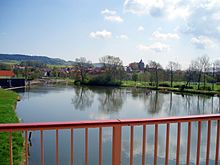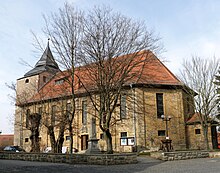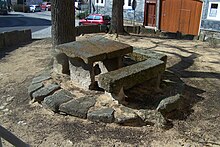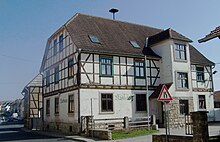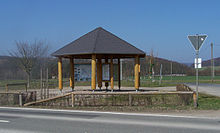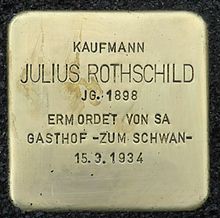Mihla
|
Mihla
City of Creuzburg
|
||
|---|---|---|
| Coordinates: 51 ° 4 ′ 38 ″ N , 10 ° 20 ′ 4 ″ E | ||
| Height : | 200 m above sea level NHN | |
| Area : | 31.66 km² | |
| Residents : | 2133 (Dec. 31, 2018) | |
| Population density : | 67 inhabitants / km² | |
| Incorporation : | December 31, 2019 | |
| Postal code : | 99831 | |
| Area code : | 036924 | |
|
Location of Mihla in Thuringia |
||
Mihla is a district of the city of Amt Creuzburg in the Wartburg district in Thuringia . Until December 31, 2019, the place was an independent municipality.
geography
The historic location is in a small valley basin of the Werra in the center of the Mihla district, on a protected hill above the Werraknie. Mihla extends on the west side of the Hainich on the east bank of the Werra. The Lauterbach flows through the village . The Lempertsbach , coming from Nazza , also flows into the Werra just below Mihla . The former Sandgut Vorwerk is located on the west bank of the Werra .
Neighboring towns are the districts of Amt Creuzburg Buchenau in the west and Ebenshausen in the northwest, followed by the communities of Nazza in the north and Lauterbach directly adjacent in the east and the Neukirchen district of the city of Eisenach and Krauthausen's district of Ütteroda in the south.
history
The place Mihla was first mentioned in the years between 780 and 802 in a deed of donation from the Fulda monastery and is therefore one of the oldest settlements in Thuringia. The predecessor building of the local church is said to have been built as the original parish of the region in the time of Christianization. On the hill above the Werra there was a church of the original parish, which was looked after by the Hersfeld monastery and later by the Fulda monastery . The tower is from the 12th century. A single-nave church extension has leaned against this Romanesque landmark since 1711.
The Gray Castle was built as a moated castle and seat of the Lords of Mihla , a branch of the Truchsesse von Schlotheim . In 1399 the lords of Roßdorf were enfeoffed with Mihla, followed by Heilingen and Wangenheim . In 1436 the von Harstall aristocratic family acquired the site and castle seat of Mihla, and they became feudal lords and court lords. From 1536 the castle was converted into a Renaissance castle by them, further changes were made in the 16th and 17th centuries. The original building, the “White Castle”, was demolished in 1836/37 and the site was incorporated into the castle park. The Harstalls also built the Red Castle in Mihla and ran a manor. The regional rule of the place in the office of Creuzburg lay with the Duchy of Saxony-Weimar or Saxony-Weimar-Eisenach .
Werra shipping played a major role for Mihla. From 1910, the town was supplied with electricity from its own hydropower plant on the Werra.
Until 1933, Mihla, with an SPD mayor, was known as the "Red Village". During the time of National Socialism , there was an economic upswing, parallel to the subsidence of the global economic crisis. One focus was 11 cigar factories with a total of 700 employees. Settlements and new streets, a large school and the first kindergarten were built. A modern reinforced concrete bridge was built over the Werra. For a short time in 1934 there was an SS leadership school in the Red Castle. Then from 1937 to the beginning of 1945 it was the seat of the female leaders' school of the female Reich Labor Service of the Gaus Thuringia. The central glider piloting school of the Gaus Thuringia, the "Thuringian Wasserkuppe", was built on the Harsberg .
During the Second World War , Pastor Moritz Mitzenheim kept a "war chronicle". In it he recorded all significant events for Mihla from 1939 to 1945. During this time he had to record 146 fallen soldiers from Mihla. A grove of honor was created for the fallen, which no longer exists. Some of the factories were converted to armaments production, for example for the manufacture of fuses. More than 80 men and women from different nations had to do forced labor in the Thuringian timber and sleeper company Ludwig Kraft in Mihla and in the Solvay plant in Buchenau . POWs were also used with the farmers and in road construction. Light flak was stationed on the Harsberg and a heavy flak battery near Bischofroda. Four Allied bombers, shot down in aerial battles, went down in the corridor of Mihla and its neighboring towns.
A Wehrmacht training company was stationed in Mihla and was reinforced at the end of March 1945 in preparation for the "battle for the Werra line" by adding a few tanks and calling up the Volkssturm . Tank traps were built and from March 31st the population was evacuated, especially into the Mihlaer Tal. On April 1, 1945, Easter Sunday , American armored spearheads appeared on the left side of the Werra. They withdrew with the loss of two tanks and the Werra bridges were blown up. Significant damage to roofs and windows occurred in the place. On April 3, Mihla was briefly shelled. Most of the armed forces withdrew. On April 4, an armed US Army jeep was destroyed by an anti-tank gun in the village, killing four American soldiers. Before that, another American vehicle had been shot down with a bazooka near the train station, leaving one dead and wounded. White flags were hoisted. US infantry entered Mihla from the direction of Creuzburg / Hahnroda using parliamentarians as living shields. At noon the place was occupied by tanks.
Several German soldiers' graves are in the cemetery, a memorial stone for the fallen Americans at the Alte Post.
In early July 1945 Mihla was incorporated into the Soviet occupation zone . From 1949 it belonged to the GDR and was close to the border area to the western zones, later to the Federal Republic. The von Harstall family was expropriated without compensation in 1945 with the Gray Castle and manor of 523 hectares. The Red Castle served the US Army and then the Red Army as a headquarters building. During this time, the valuable and previously well-preserved interior was destroyed and the associated park was also devastated. The Red Castle and the manor with Vorwerk Wernershausen (475 ha) were also expropriated.
The political community Mihla consisted of the district reform of 1994 from the districts Mihla and Buchenau, which was incorporated into Mihla. The decision to merge the municipality of Mihla with the city of Creuzburg and the municipality of Ebenshausen to form the city of Creuzburg was taken in October 2018. The Thuringian law on the voluntary reorganization of municipalities belonging to the district in 2019 was passed by the Thuringian state parliament on September 12, 2019 and came into force on December 31, 2019.
Culture and sights
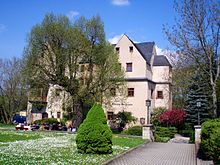

Architectural monuments
- The gray castle dates from the 16th century and is surrounded by a small castle park. Conversions took place in the 17th century. Today the castle is a restaurant with guest rooms.
- The Red Castle also dates from the 16th century and is one of the most important Renaissance half-timbered buildings in the Wartburg district. Modifications were made in the 17th and 18th centuries. After the end of the war in 1945, the art-historically valuable interior was lost. Since 1952 the castle has been used as a retirement and nursing home. It is currently for sale.
- The Evangelical Church of St. Martin is a baroque hall church from the 18th century and has a rococo interior. The low tower with the characteristic flat tower spire comes from the Romanesque previous building from the 12th century. Next to the church in the direction of Anger is an open half-timbered building with three bells. Some historical gravestones still come from the former churchyard. Next to the church is an obelisk in memory of the Mihla soldiers who died in the Franco-Prussian War of 1870/71.
- The Mihlaer Dorfanger has been the center of the village and the place of village jurisdiction since the 13th century, and since 1682 also the court of the Lords of Harstall and the fairground. The green is surrounded by a church, a former knight's seat, a community tavern and a former community baking house. After the First World War, the community erected its war memorial on the church wall in the direction of Anger.
- The town hall is a simple half-timbered building. The neighboring building of the former Carl-Alexander-Schule serves as an annex building to the town hall (motto on the facade: “Without cultivation, no fruit, without diligence, no price”).
- The Mihlaer Propel is a linden tree-lined square above the Werra. In 1254 it was mentioned in a document as the landgrave's court in Brachbühl (colloquial as "Propel"). Later bird shooting and fairs were held here. Even today, the Propel is the most popular fairground for the Mihla people.
- Mihla owns many listed half-timbered houses from the 17th century. Famous is the Holzerkopfhaus , a representative half-timbered house and other half-timbered houses from the time of the Werra rafting.
- The old ferry house as evidence of the ferry connection from Mihla to Sandgut, which was discontinued in 1870 with the construction of the first Werra bridge, is in a very poor structural condition.
Nature reserves and monuments
The Lienig nature reserve has an area of 24.88 hectares . It was expelled on March 23, 1961.
The 250 to 300 year old linden tree in front of the Gray Castle had been designated as a natural monument since 1966 . It had to be felled in 2013 because the stability was no longer guaranteed.
Stumbling block (s)
On June 18, 2015, in the presence of representatives of the city administration and interested citizens, a stumbling block was set by Gunter Demnig in a small celebration in memory of Julius Rothschild, whose last voluntary residence was at this point.
Surroundings
The vicinity of Mihla also has a variety of sights and leisure opportunities. Numerous hiking trails open up the Hainich and the Werra Valley. Water hiking on the Werra is particularly popular . The Werra cycle path also leads through Mihla.
Mihla is a traditional center of equestrian sport, the Mihlaer Jugend provides a riding group in historical uniform at every fair.
The youth hostel at Harsberg im Hainich is located 4 km east of Mihla. Glider flights were operated here from 1932 to 1945 , and there was a flying school of the Gaus Thuringia until the end of World War II . The gliders were burned by US soldiers in April 1945, the buildings - except for the restored hangar - were later demolished. The current facility was built in the 1950s, and architecturally it must have been built according to plans from the 1930s. It was used by the Society for Sport and Technology until, in the early 1960s, gliding near the border was no longer possible. Now a training unit of the GDR border troops moved into quarters here until 1990. After years of vacancy, a youth hostel was set up, which was recognized for its quality in 2008. The view from Mihla to the south is dominated by wind turbines on the Mihlaer Berg near Neukirchen .
Economy and Infrastructure
- The Buchenau industrial park is located on the eastern outskirts of Buchenau. It has a total area of 18 ha (as of 1998) and was built on the industrial wasteland of the former soda factory.
- The Reitberg industrial park is located south of Mihla and is the location of an agricultural cooperative.
Further operating locations are on the western outskirts of Mihla in the vicinity of the former train station. The municipality of Mihla has its own sewage treatment plant, located in the Werra floodplain opposite the town. The Werra's hydropower is used by the newly built hydropower plant at Mihlaer Wehr.
traffic
State road 1016, which connects Eisenach with Mühlhausen, runs through Mihla .
The Schwebda – Wartha railway, which went into operation in 1907 , connected Mihla with Eisenach , Creuzburg, Treffurt , Wanfried and Eschwege . Due to the demolition of the Werra bridges at Mihla, Frankenroda and Falken at the end of the Second World War and the subsequent demarcation of the border, traffic to Eschwege was no longer possible from 1945 onwards. Passenger traffic between Mihla and Wartha via Creuzburg was stopped in 1962.
Mihla is connected to the surrounding communities with various Wartburgmobil bus routes.
politics
Municipal council
The municipal council of Mihla finally consisted of 14 councilors.
Political party |
Seats
|
| Independent voting community Mihla (UWG) |
8 (−2)
|
| CDU |
3 (+3)
|
| SPD |
1 (−2)
|
| NPD |
1
|
| FDP |
1
|
(As of: local election on May 26, 2019 )
Mayor since 1990
| mayor | from | to |
|---|---|---|
| Günther Nickol | 1954 | 1990 |
| Siegfried Kärger | 1994 | 1999 |
| Rainer Lämmerhirt | 1999 | 2019 |
Personalities
Sons and daughters of the place
- Ernst Christoph Homburg (1607–1681), lyric poet, Protestant hymn poet and translator
People related to the place
- August Anhalt (1899–1975), painter, draftsman and graphic artist of the modern age
literature
- Rainer Lämmerhirt : Mihla. From the story of a village in West Thuringia . Heimat- und Verkehrsverein, Mihla 1993 ( West Thuringian Heimatschriften special volume, ZDB -ID 2285013-2 ).
- Rainer Lämmerhirt, Brundhilde Hoffmann: Village pictures from old Mihla . 2 volumes. Heimat- und Verkehrsverein e. V., Mihla 1995–1997 ( West Thuringian Heimatschriften 6 and 8).
- Rainer Lämmerhirt: From World War to World War. Mihla and the Werra region from 1919 to 1945 . Verlag Rockstuhl, Bad Langensalza 2006, ISBN 3-938997-40-0 ( West Thuringian Heimatschriften 14).
Individual evidence
- ^ Werner Hermann Dorfkirchen in Thüringen Verlagshaus Thuringia, 1992, ISBN 3-86087-014-9 , p. 63
- ↑ Pictures from the time of the leadership school in the Red Castle Mihla . Werratal-Bote No. 23/2010
- ↑ Thuringian Association of the Persecuted of the Nazi Regime - Association of Antifascists and Study Group of German Resistance 1933–1945 (ed.): Heimatgeschichtlicher Wegweiser to sites of resistance and persecution 1933–1945, series: Heimatgeschichtliche Wegweiser Volume 8 Thüringen, Erfurt 2003, p. 327 , ISBN 3-88864-343-0
- ^ Rainer Lämmerhirt: The fight for the Werra line in 1945 . Rockstuhl Verlag, Bad Langensalza 2005. ISBN 3-937135-64-2 . P. 105
- ^ Thuringian ordinance on the dissolution of the Buchenau community and its incorporation into the Mihla community of March 25, 1994 (GVBl p. 386)
- ↑ The unified community in the Werratal is to be named Stadt Amt Creuzburg - Article in the Thuringian regional newspaper of February 9, 2019 , accessed on October 23, 2019
- ↑ Thuringian law on the voluntary reorganization of municipalities belonging to the district in 2019 and on the adjustment of court organizational regulations in Thuringian Law and Ordinance Gazette No. 11/2019 of October 18, 2019, p. 385 ff., Accessed on October 23, 2019
- ↑ Sandgut on the website of the Mihla municipality, accessed on January 31, 2019
- ^ Klaus Schmidt: The Wartburg district. Nature and landscape . In: Wartburgkreis (Ed.): Nature conservation in the Wartburgkreis . tape 7 . Printing and publishing house Frisch, Eisenach and Bad Salzungen 1999, p. 87 .
- ^ Biedermann: Natural monuments in the Wartburg district; District Office Wartburgkreis, 2014, page 33
- ↑ District Office Wartburgkreis (Ed.) The business location Wartburgkreis - City of Eisenach. Info folder Bad Salzungen / Eisenach 1998. P. 4 ff.
- ↑ Local elections in Thuringia on May 26, 2019. Elections of the community and city council members. Preliminary results. The regional returning officer, accessed on May 29, 2019 .
- ↑ The youngest mayor is now one of the oldest in town , Thüringer Allgemeine / Eisenacher Allgemeine, November 12, 2019
- ↑ Local elections in Thuringia on June 12th, 1994 - mayoral election 1994. Final results. The regional returning officer, accessed on November 14, 2019 .
- ↑ Local elections in Thuringia on June 13th, 1999 - Mayor election 1999. Final results. The regional returning officer, accessed on November 14, 2019 .


